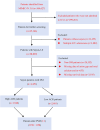Association between anion gap/calcium ratio and 30-day all-cause mortality in sepsis patients with diabetes mellitus
- PMID: 39732874
- PMCID: PMC11682128
- DOI: 10.1038/s41598-024-82700-4
Association between anion gap/calcium ratio and 30-day all-cause mortality in sepsis patients with diabetes mellitus
Abstract
We aimed to determine the association between anion gap-to-calcium ratio (ACR) and 30-day mortality in sepsis patients with diabetes mellitus (DM). Data for sepsis patients diagnosed with DM was extracted from Medical Information Mart for Intensive Care Database IV. After screening, 4429 eligible subjects were included in our study finally. The receiver operating characteristic (ROC) curve was used to determine the cut-off value. According to the ROC curve analysis, the ACR demonstrated a higher area under the curve (AUC) of 0.622 compared to AG (0.598). Multivariable logistic regression with inverse probability of treatment weighting (IPTW) based on propensity score were used to detect the association between ACR and 30-day mortality. Our results showed that the patients with the high level of ACR had a higher risk of death within 30 days compared with those with low level of ACR (odds ratio 1.342, 95% confidence interval 1.180-1.526, P < 0.001). In a word, our results suggest that ACR may be an independent prognostic indicator for death with 30 days in critically ill patients with sepsis and DM.
Keywords: Anion gap; Calcium; Diabetes mellitus (DM); Mortality; Sepsis.
© 2024. The Author(s).
Conflict of interest statement
Declarations. Competing interests: The authors declare no competing interests.
Figures



Similar articles
-
Association between anion gap and all-cause mortality of critically ill surgical patients: a retrospective cohort study.BMC Surg. 2023 Aug 9;23(1):226. doi: 10.1186/s12893-023-02137-w. BMC Surg. 2023. PMID: 37559030 Free PMC article.
-
[Monocyte/lymphocyte ratio as a predictor of 30-day mortality and adverse events in critically ill patients: analysis of the MIMIC-III database].Zhonghua Wei Zhong Bing Ji Jiu Yi Xue. 2021 May;33(5):582-586. doi: 10.3760/cma.j.cn121430-20201223-00772. Zhonghua Wei Zhong Bing Ji Jiu Yi Xue. 2021. PMID: 34112297 Chinese.
-
Serum Anion Gap Level Predicts All-Cause Mortality in Septic Patients: A Retrospective Study Based on the MIMIC III Database.J Intensive Care Med. 2023 Apr;38(4):349-357. doi: 10.1177/08850666221123483. Epub 2022 Sep 6. J Intensive Care Med. 2023. PMID: 36066040
-
Association between the anion-gap and 28-day mortality in critically ill adult patients with sepsis: A retrospective cohort study.Medicine (Baltimore). 2024 Jul 26;103(30):e39029. doi: 10.1097/MD.0000000000039029. Medicine (Baltimore). 2024. PMID: 39058855 Free PMC article.
-
[Association between blood glucose-to-lymphocyte ratio and prognosis of patients with sepsis-associated acute kidney injury].Zhonghua Wei Zhong Bing Ji Jiu Yi Xue. 2023 Dec;35(12):1262-1267. doi: 10.3760/cma.j.cn121430-20230901-00725. Zhonghua Wei Zhong Bing Ji Jiu Yi Xue. 2023. PMID: 38149387 Chinese.
References
-
- Schertzer, J. D. & Steinberg, G. R. Immunometabolism: The interface of immune and metabolic responses in disease. Innunol. Cell. Biol.92(4), 303. 10.1038/icb.2014.12 (2014). - PubMed
-
- Donath, M. Y. & Shoelson, S. E. Type 2 diabetes as an inflammatory disease. Nat. Rev. Immunol.11(2), 98–107. 10.1038/nri2925 (2011). - PubMed
-
- Devaraj, S., Venugopal, S. K., Singh, U. & Jialal, I. Hyperglycemia induces monocytic release of interleukin-6 via induction of protein kinase c-{alpha} and -{beta}. Diabetes54(1), 85–91. 10.2337/diabetes.54.1.85 (2005). - PubMed
MeSH terms
Substances
LinkOut - more resources
Full Text Sources
Medical
Miscellaneous

